17.9.2018
by Roger Blum
Diving in Russia
Siberian Adventure
Diving in Lake Baikal
|
|
In the summer of 2018 together with four other divers from Adlershof diving club, I made my way to one of the best freshwater diving spots in the world: Lake Baikal in eastern Russia. We had been told many times about the lake’s excellent visibility, its incredible drop offs and the unique fauna and flora living there. About two thirds of animal species that reside in its water are said to be endemic. Nothing to do with diseases, it means they live exclusively in Lake Baikal. If you take this into account, its obvious that we had high expectations for our diving trip to Siberia. Since tour operators were demanding incredibly high prices, we organized our trip by ourselves. We booked a flight with Aeroflot and some of our acquaintances put us in touch with Baikal locals Igor and Olga, who run a small guesthouse near the lake.
|
|
After a short stopover in Moscow and a six-hour connecting flight, we arrived in Irkutsk, the capital of the region and the biggest city near the lake. Igor was waiting for us at the airport. We’d brought so much diving luggage and photo equipment along that it was quite cramped inside his minivan. Luckily it was only 70 km to Lake Baikal. Before heading off, we stopped at several different banks to stock up on rubles. We had to do this because ATMs in Russia often have a limited amount of cash inside, with others sometimes left completely empty.
|
|
Arrival and our accommodation in Nikola
|
Two hours later we moved into our accommodation in Nikola, a small village on the Angara River. Our guesthouse was situated on a small hill from where it’s usually possible to see the lake in good weather. However, on our arrival our view was blocked by fog and drizzle. But this didn’t dampen our spirits.
We toasted our arrival with a Baikal vodka as Igor started to serve dinner. It was then that we got our first taste of the lake. "The soup is looking at me," my dive buddy said. A fish head was poking out of his bowl, fixing my friend with a stare. "Omul" Igor replied. The Baikal-Omul, a local whitefish, is found exclusively in Lake Baikal... and now it was to be found in our soup. So we got to meet our first endemic fish of the area on the day of our arrival - without even having seen the lake.
|
|
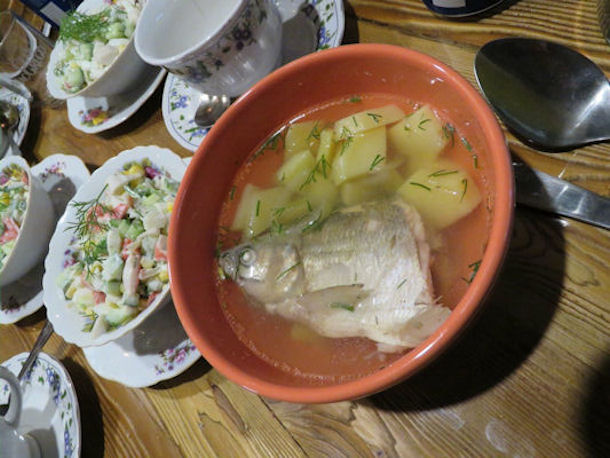
|
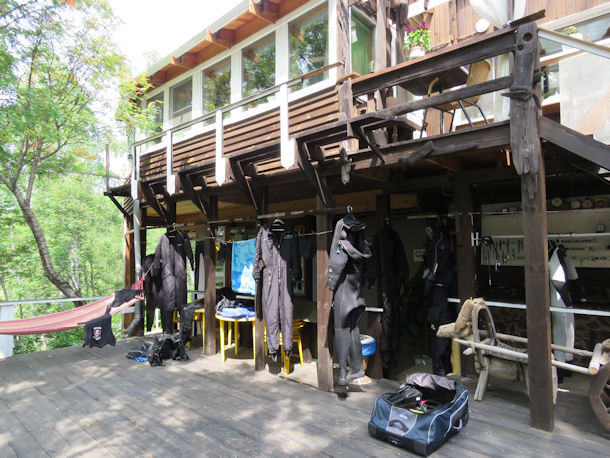
|
|
In the evening we met our dive guide Andrej. A friendly chappy, he was a trainer at the Russian Ministry of Emergency Situations, better known as EMERCOM (or formally as the Ministry of the Russian Federation for Affairs for Civil Defence, Emergencies and Elimination of Consequences of Natural Disasters). The ministry is responsible for land, sea, and air rescue operations. Their local Baikal base was housed in a huge aerodrome. As Andrej led us through the hall, I couldn’t help thinking of an army barracks. The premises boast a swimming pool and a climbing wall. But there was also a diving pool, two diving towers, and two modern decompression chambers. The facilities were state-of-the-art and incredibly well maintained.
|
|
Our diving base was located near the Russian Ministry of Emergency Situations
|
|
In the morning we packed up our diving suits, tanks and weights, and drove on to the locality of Listvyanka. Finally it lay in front of us - Lake Baikal, the largest freshwater lake on earth. In existence for over 25 million years and boasting a depth of 1,642 metres, it’s oldest and deepest freshwater lake on earth. In Listvyanka, there were numerous dive sites at our disposal. From this point we could dive from the shore without any problems. Along the promenade there are many small pebble beaches that can be used as entry points.
|
|
On the shore of Lake Baikal
|
|
The first dive we did was at what can only be described as an anchor cemetery. The entrance can be reached via a former boat ramp. Despite it being high summer, the water was ice-cold. My dive computer indicated that the water temperature was just 4 degrees. Dry suits and cold water regulators are a necessity. After diving about 100 meters we reached the wreck of a small patrol boat. An armament on the bow was clearly visible. We went on to dive between several man-sized anchors dotted along the lakebed in close succession.
|
|
Anchor cemetery and wreck of a small patrol boat
|
|
The next day we made two dives near the River Krestovka. We swam along the rock face and got to see green sponges, Baikal sculpins and flea crabs, all typical examples of the endemic species living in Lake Baikal. They account for 90% of the biomass of Lake Baikal. I had read that the amphipods attack the submerged carcasses of fish and birds in a swarm, and within a few days they can even strip a pig down to its bones. It’s said that a human corpse needs to be found within seven days, otherwise there will be very little left of it. The fist-sized Gammarus Flea Crayfish or Anthogammus victorii are some of the worst culprits. Hundreds of these animals lie motionless at the bottom of the lake and on rock faces, offering countless opportunities for beautiful photographs. A particularly conspicuous feature of these orangey-yellow, giant shrimps is the two clearly visible spines that poke out of their sides.
|
|
|
Flea Crayfish Anthogammus victorii
|
|
After the dive we had to free Andrej´s Lada from a sticky situation.
|
|
Before we drove back to our homestay, we visited the Baikal Museum in Listvyanka, a natural history museum run by the Russian Academy of Sciences. In the small museum we were able to learn more about the history of Lake Baikal and its unique flora and fauna. We were given the chance to look at a species of tiny flea crayfish under a microscope, and undertook a simulated sub-marine dive to the bottom of the lake.
|
|
Visiting the Baikal Museum in Listvyanka
|
|
The following day Andrej organized a boat trip to Port Baikal. Also on board was Igor, who took care of our physical wellbeing, as well as Andrej’s wife Mrs. Sasha and their three children. We set off from the station in a disaster control boat, travelling along the fog-set Angara River, past the famous Shaman Stone, and out onto the lake. The stone rises out of the water near Listvyanka and marks the border between Lake Baikal and the Angara River.
|
|
|
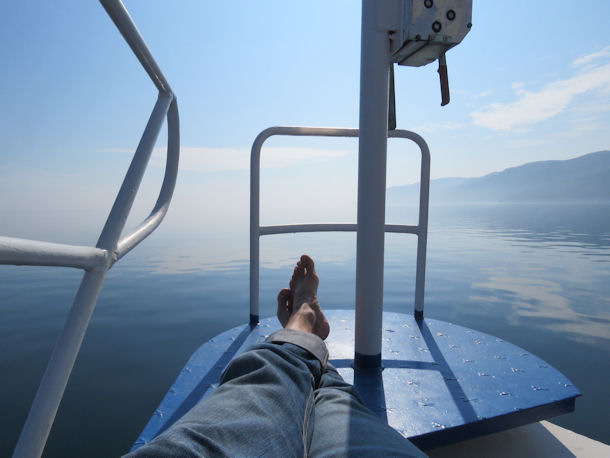
|
|
Many legends and stories surround Port Baikal. One such tale is the legend of tsarist admiral Alexander Kolchak and his sunken gold. Following the deposition of Tsar Nicholas II, Kolchack was briefly recognised by the anti-Communist White movement (and internationally) as the Supreme Ruler of Russia. During this time, Kolchak’s troops allegedly captured several tons of the tsar's gold. Moving the gold south by train, the vehicle is said to have derailed on a slope overlooking the shores of Lake Baikal and plunged into the icy depths of its waters. Ever since, treasure hunters have tried to locate the Admiral's gold. Andrej told us with a wink that he knew the place where the gold was. From time to time he apparently dives down and fetches a bar. It was reportedly enough to get him by for a while. We laughed.
On our last evening with Andrej, he gave us an old bottle found at the lake bottom that dates back to Russia’s revolutionary period, a souvenir for our very own diving museum.
|

|
|
|
Only a few meters away from our boat I saw my first Baikal seal. With its surprisingly big head and large eyes, the sea critter was incredibly cute. These particular seals can only be found in Lake Baikal and are the only ones of their kind to live exclusively in fresh water. On our following adventures we would see Baikal seals again and again. They had the endearing habit of stretching their heads out of the water in curiosity to watch us. Unfortunately we didn’t get to observe the animals under water.
|
|
|
Baikal seal (Pusa sibirica)
|
|
Directly in front of the pier of Port Baikal (GPS: 51,8696678° N, 104,8441790° O) lays all kinds of cultural refuse from bygone eras. Several parts of the harbour’s fortifications once slipped into the waters below and today offer shelter for Baikal sculpins, snails and flea crabs. Having explored beneath the pier, we then swam along a steep rock face completely covered in green sponges that are so typical of Lake Baikal. After almost 40 minutes under water, the cold was starting to penetrate my dry suit (along with some water that had managed to get in through a small hole), forcing me to emerge.
|
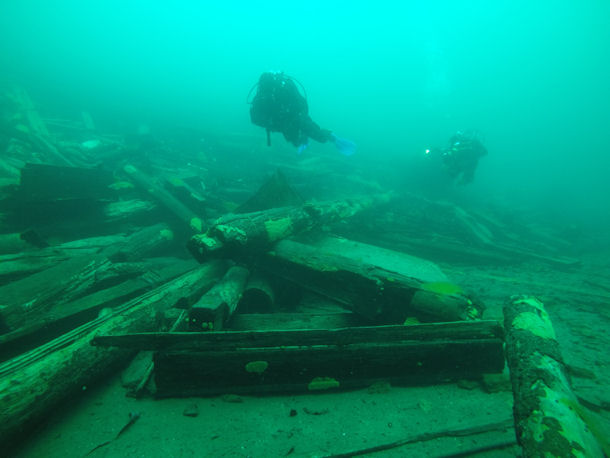
|
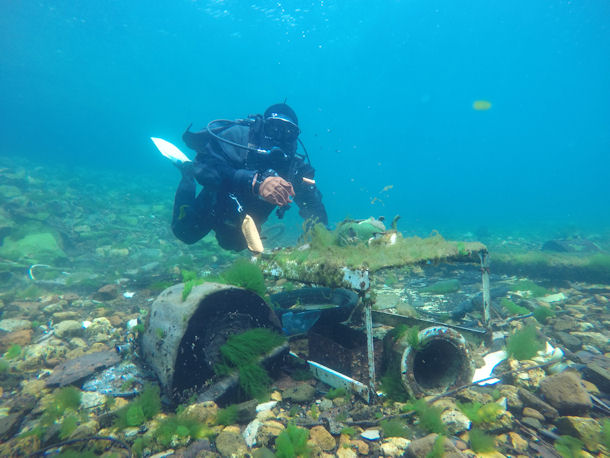
|
|
In the evening we celebrated the birthday of one of fellow divers, Dieter. Our host Olga had baked a cake, while Nastasia, Olga and Igor's daughter had brought champagne from Irkutsk. Our hosts had decorated the room with flowers and candles. In the evening Andrej and Sasha also came along. Everything was - as always - very warm and homely as we knocked back small glasses of whiskey and "Pajechali" vodka one after another.
|
|
Another interesting excursion led us to Talzy on the banks of the Angara River (GPS: 51,9894584°N, 104,6671018°E). The small village, halfway between Listvyanka and Irkutsk, is situated in a dense forest of Birch trees. Here we explored the remains of a lost village. A few stones showing signs of human treatment and the occasional pot and bottle testified to the fact that there had once been a small village here. The lack of any obvious remains can be explained by the fact that in Siberia, houses are typically built from wooden planks instead of bricks.
|
|
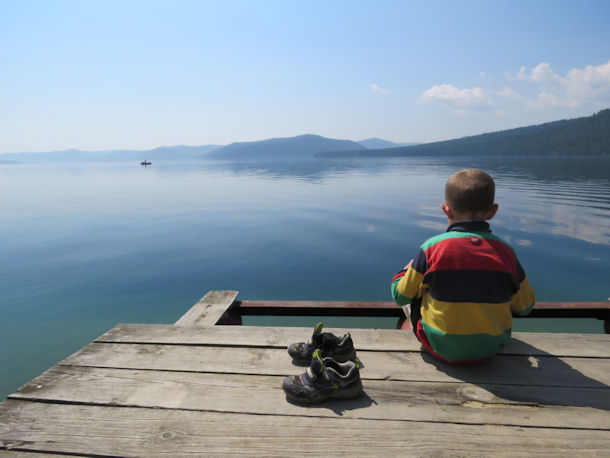
|
|
It goes without saying that we also spent a lot of our time here diving. At the same level as the "Y Ocepa" hotel, Russian for "Our lake" (GPS: 51,8642539° N, 104,8441790° E), there is a small beach area that can be reached by a dilapidated stairway, which is in desperate need of renovation. At a depth of about 16 meters lies the wreck of a little Zhiguli. The car, made by Soviet automobile manufacturer AwtoWAS, was a license replica of the Fiat 124 and made up about half of the Soviet Union’s car production in the 1970s. We weren’t able to find out how the car ended up at the bottom of the lake. It’s possible that it had been parked on the ice and had sunk with the thaw. Maybe it had descended into the water especially for the divers.
|
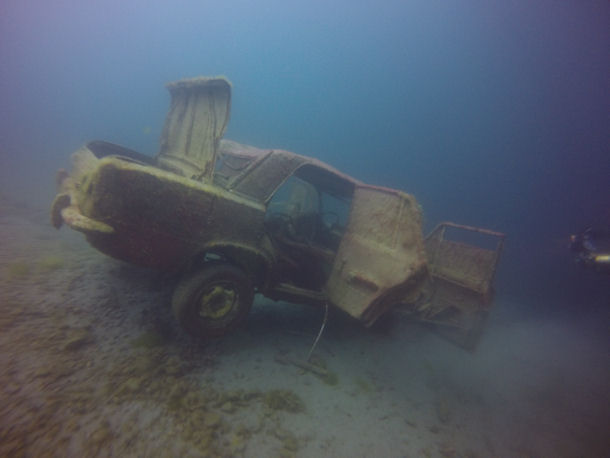
|
|
Aqua Eco (GPS: 51,8535041° N, 104,8636212° E) is another interesting dive site in Listvyanka. Here you can see the remains of an old wooden pier. The site was destroyed after the damming of the Angara in the 1950s caused water levels to rise. The dive site is located next to the main road that runs along Listvyanka’s shores. There was such little space along the stony beach that we had to get changed on the opposite side of the road behind the ruins of an old house, and then cut across again in full diving gear. A small rusty staircase leads from the shore promenade to the water.
|
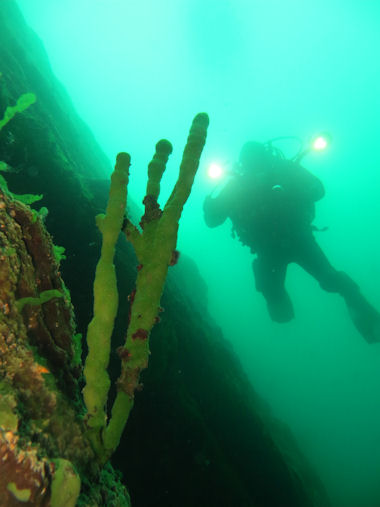
|
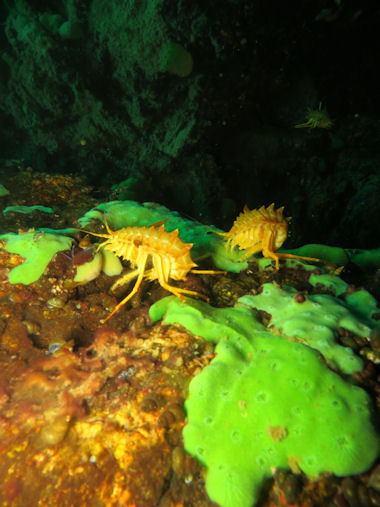
|
|
First we dived out about 60 to 80 meters from the shore at went down three to five meters deep, swimming over a slowly sloping sandy area that is densely covered with green algae and plants. Large stones and logs offered shelter for Baikal sculpins. With thick heads, broad mouths, and lower bodies that taper back to the caudal fin like a club, there is something very conspicuous about this fish. Most species are endemic, so they only occur in the region around Lake Baikal and its adjacent rivers.
|
|
Then we reached the edge of the abyss. The area drops steeply to a depth of more than 30 meters. The visibility was very good, at least 20 meters.
|
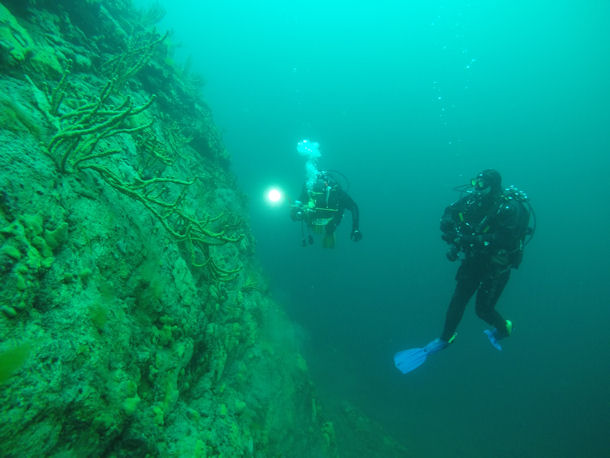
|
|
The rock area was interrupted by a large sandy slope. Each way we turned were long, thick tree trunks, which were obviously part of the former pier. The trunks had apparently fallen down the slope. At the 10-meter-level, I saw three well preserved rectangular wooden board boundaries, all densely populated with algae, overgrown with plants, and filled with boulders. These could have been small buildings that used to stand in front of the former wooden pier, where ships could more along the shore. We had already seen similar constructions, but properly preserved, at other sites around Lake Baikal during our boat trips. The diving in the flat area offered the possibility to observe a plethora of smaller organisms. Small sculpins dashed over the sand or hid themselves amongst the algae-painted stones. Snails grazed industriously on the algae. A paradise for macro-photographers.
|
|
|

|
|
The last excursion of the trip led us to the peninsula of Cape Sabre. We drove with the boat for several hours in a northerly direction along the lake’s rugged western shore, densely covered with coniferous forest. Underwater, the visibility and the variety of the sponges was overwhelming. They "grow" in the most different forms and populate the rock reefs and drop-offs of the lake. They form partial coral-like columns, which can reach up to a height of one-meter. At some dive sites, including Cape Sabre, the sponges were so numerous that the scenery reminded me a little of a coral reef. The main difference was the water temperature. Here at Lake Baikal, it’s just four to five degrees Celius.
|
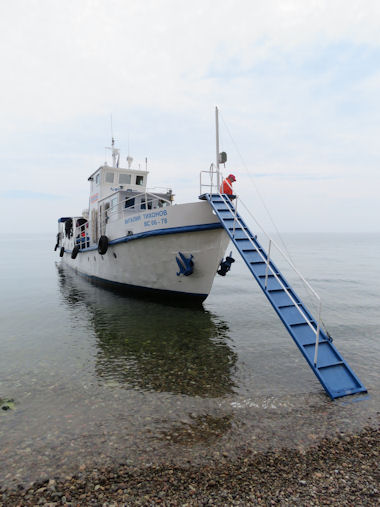 |
|
|
In the evening Igor barbecued fish and we used the Banja, the Russian version of a sauna, to warm up again. Our host Igor had collected all kinds of wood and stones during our dives and had made a small work of art from them to serve as a memory of our trip. The farewell was very warm and we promised to keep in contact. Hopefully we will indeed see each other again. All in all, it was a great journey. During our stay not only did we get to discover the fascinating underwater world of Lake Baikal, but we also got to know some really great people. We came as guests but left as friends.
|
|
|
Could be interesing for you:
|
|
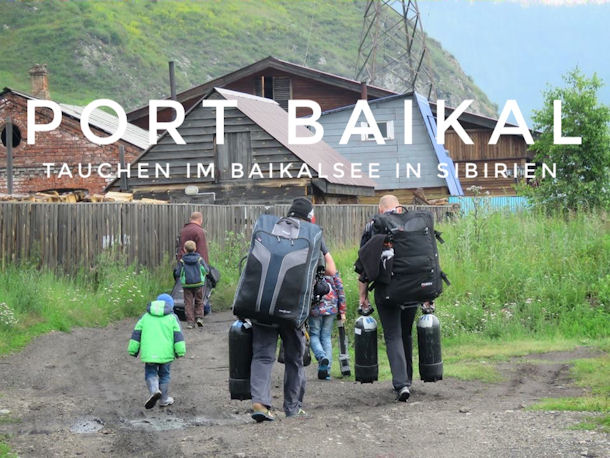
Port Baikal – Tauchen an der vergessenen Stadt (Russland)
Vor mir liegt der Baikalsee, der der größte Süßwassersee der Erde. Mit 1642 m Tiefe ist er der tiefste und mit über 25 Millionen Jahren der älteste Süßwassersee der Erde. Der See besitzt eine einzigartige Flora und Fauna. Von den etwa 2.500 hier vorkommenden Tier- und Pflanzenarten sollen etwa 2/3 endemisch sein, d.h. ausschließlich im und um den Baikalsee vorkommen. Diese wollten wir in den nächsten Tagen kennenlernen.
[mehr]
|
|

Angara – Flusstauchen in Sibirien (Russland)
Irgendwo auf halber Strecke zwischen Listwjanka und Irkurtsk bogen wir in einen dichten Birkenwald und fuhren zum Flussufer. Ein leichter Nebel lag noch über dem Fluss. Die Sonne schien und das Wasser lud zum Baden und Tauchen ein. Doch auch im Hochsommer ist das Wasser kalt. 6 °C zeigte mein Thermometer an. Einige von uns gingen trotzdem Baden. Respekt. Ich mummelte mich lieber in meinen Trockenanzug und bereite mich auf den Tauchgang vor. Wir wollten die Überreste eines versunkenen Dorfs erkunden. Bevor in den 1950ier Jahren das Wasser der Angara in Irkutsk angestaut wurde, soll sich hier am Flussufer ein kleines Dorf befunden haben.
[mehr]
|
|
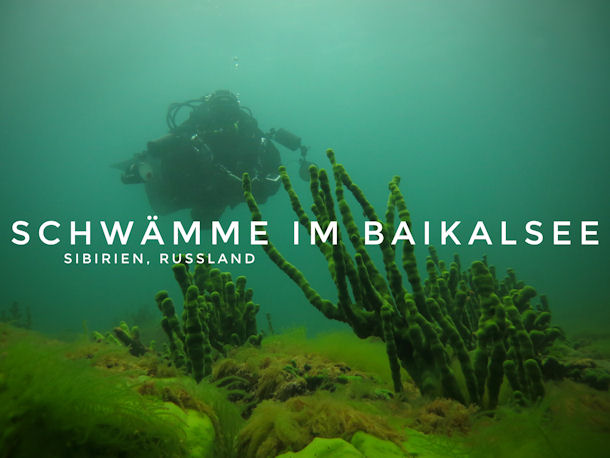
Schwämme im Baikalsee (Russland)
Typisch für den Baikalsee sind die allgegenwärtigen Baikalschwämme. Sie „wachsen“ in den unterschiedlichsten Formen und besiedeln die Felsenriffe und Drop-Offs des Sees. Teilweise bilden sich korallenähnliche Säulengebilde, die bis zu einem Meter Höhe erreichen können. An manchen Tauchplätzen waren die Schwämme so zahlreich, dass mich die Szenerie ein wenig an ein Korallenriff erinnerte. Nur dass die Wassertemperatur hier am Baikalsee gerade einmal 4 bis 5 Grad Celius betrug. Die Familie der Baikalschwämme (Lubomirskiidae) besteht insgesamt aus vier Gattungen und zwölf Arten.
[mehr]
|
|
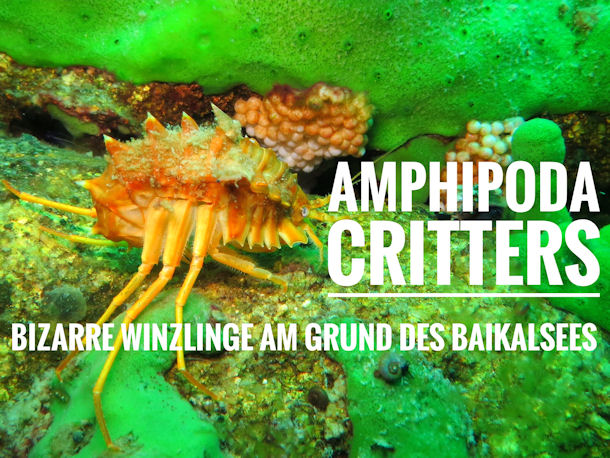
Amphipoda - Bizarre Winzlinge am Grund des Baikalsees (Russland)
Der im Herzen Sibiriens, an der Südostgrenze Russlands zur Mongolei, liegende Baikalsee ist der tiefste und älteste See der Erde. Er gilt als eines der artenreichsten Süßwasserbiotope der Erde und ist ein beliebtes Ziel für Taucher und Biologen. Hier leben eine Vielzahl endemischer Tier- und Pflanzenarten. Besonders speziell sind die im Baikal lebenden Flohkrebse (Amphipoda). Die kleinen Wasserbewohner sind für die Reinhaltung des Wassers von großer Bedeutung. Sie fressen alle organischen Überreste von toten Tieren und Pflanzen. Die Flohkrebse machen 90 % der Biomasse des Baikalsees aus.
[mehr]
|
|
Verpasse keinen unserer Artikel mehr und folge uns auch auf Facebook, Youtube, Instagram oder Twitter. Hier gibt’s ständig aktuelle Artikel, Bilder und Videos von unseren Taucherfahrungen und -abenteuern.
|
|
|

